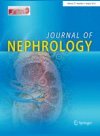Role of anemia and proteinuria in the development of subsequent renal function deterioration in a general population with preserved glomerular filtration rate: a community-based cohort study
Abstract
Background
Risk factors for renal function deterioration in the general population are not fully understood. We aimed to clarify the determinants of estimated glomerular filtration rate (eGFR) decline using a community-based cohort.
Methods and results
Among 3217 subjects who underwent repeated health check-ups, we excluded 478 subjects with eGFR ≤ 60 mL/min/1.73 m2 and examined 2739 subjects. EGFR decline rate was calculated from the difference in eGFR between the first and last visits. EGFR decline, which was defined as a drop in GFR accompanied by a 25% or greater drop in eGFR from baseline and/or a sustained decline of more than 5 mL/min/1.73 m2/year, was observed in 209 subjects (7.6%). Anemia according to the WHO definition (16.7% vs. 11.7%, p = 0.03), and proteinuria (3.3% vs. 0.8%, p < 0.001) at baseline were more commonly observed in subjects with eGFR decline. Multivariable logistic regression analysis showed that anemia and proteinuria were independently associated with eGFR decline.
Conclusion
Anemia and proteinuria were closely related to eGFR decline, which suggests that we should consider these parameters as risk factors of the development of renal function deterioration even in the general population.



